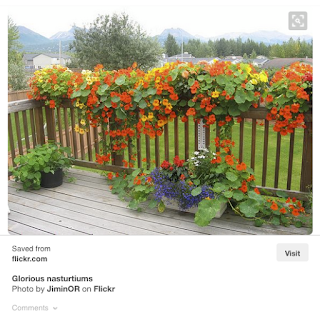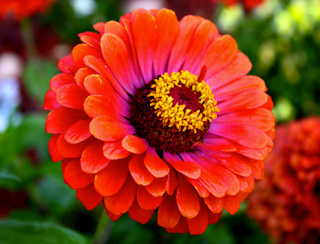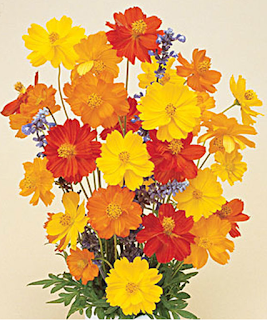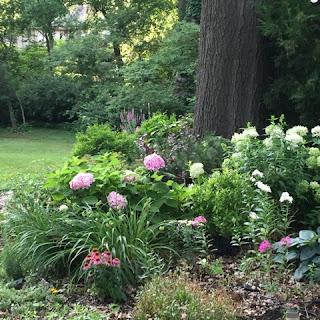Monday, August 5, 2019
Friday, May 11, 2018
Favorite Plants from Seeds
Easy to grow seeds for a
bright summer punch of color in your Garden.
1. Nasturtium .
- Plant these easy care seeds in your garden for bright color. Personally, I love the orange ones. I'm a little obsessed with planting these in every container (spilling over)
These flowers trail happily from containers and thrive in sunny spots in your garden or patio.
Thrillers, Spillers and Fillers (P. Allen Smith)
Nasturtium seeds are great for teaching kids to plant, grow and enjoy flowers.
Even I can grow Nasturtium. The seeds are large, easy for kids to pick up. They grow and bloom profusely all summer.
These flowers are also edible and add color to a summer salad.
Nasturtium are Annuals.
2. Marigolds
Bright sunny Marigolds.
What a big punch of color from such a small seed!
Sow in groupings of the same color for a big impact wave of color.
(I love to pair these with Nasturtiums in pots- as part of the Thriller, Spiller and Filler theory, - Thank you, "P. Allen Smith")
- sow seeds directly into the soil, a pot or in the ground for easy bright color all season. Marigolds are Annuals- hmmm, there may be some Zinnias in the photo below from Google Maragold search...? The Marigold is fun to see and brightens any day.
3. Zinnias - quick to grow and colorful
provides beautiful color and texture. Sunny area. likes moist soil. plant from seed into soil, water soil from below, not above flower. soil not amended ok- watch out for powdery mildew
(my notes below are from Burpee seeds, - link to a Burpee Seed online catalog, or Google Burpee Seeds Zinnia )
Zinnias are recommended for beginning gardeners.
Zinnias are undemanding annuals that simply need full sun, warmth, and well-drained soil rich in organic matter. If soil is poor, incorporate lots of compost or leaf mold. Zinnias can be direct sown or transplanted into the garden. Space taller varieties about 12 to 18 inches apart. Space shorter growing varieties about 6 to 8 inches apart.
(-I've planted dozens of Zinnias in a sunny spot. I'll post a photo later, fingers crossed ; )
4. Cosmos -
provides beautiful color and texture. Sunny area. likes moist soil. plant from seed into soil, **note** Cosmos likes to be watered in the soil below, not above, on the flower or leaves.
(text from Burpee Seed Online Catalogue)
Bright sunny Marigolds.
What a big punch of color from such a small seed!
Sow in groupings of the same color for a big impact wave of color.
(I love to pair these with Nasturtiums in pots- as part of the Thriller, Spiller and Filler theory, - Thank you, "P. Allen Smith")
- sow seeds directly into the soil, a pot or in the ground for easy bright color all season. Marigolds are Annuals- hmmm, there may be some Zinnias in the photo below from Google Maragold search...? The Marigold is fun to see and brightens any day.
3. Zinnias - quick to grow and colorful
provides beautiful color and texture. Sunny area. likes moist soil. plant from seed into soil, water soil from below, not above flower. soil not amended ok- watch out for powdery mildew
(my notes below are from Burpee seeds, - link to a Burpee Seed online catalog, or Google Burpee Seeds Zinnia )
Zinnias are recommended for beginning gardeners.
Zinnias are undemanding annuals that simply need full sun, warmth, and well-drained soil rich in organic matter. If soil is poor, incorporate lots of compost or leaf mold. Zinnias can be direct sown or transplanted into the garden. Space taller varieties about 12 to 18 inches apart. Space shorter growing varieties about 6 to 8 inches apart.
(-I've planted dozens of Zinnias in a sunny spot. I'll post a photo later, fingers crossed ; )
4. Cosmos -
provides beautiful color and texture. Sunny area. likes moist soil. plant from seed into soil, **note** Cosmos likes to be watered in the soil below, not above, on the flower or leaves.
(text from Burpee Seed Online Catalogue)
Febuary- Time to paint the garden!
 Oh! How I love to paint the garden in Feb.
Oh! How I love to paint the garden in Feb.(Such a dreary dull time. Why is Valentine's day in Feb? Maybe to give people a little lift )
Thinking of spring is warmth.
Petunias with creeping jenny, vivacious purples and chartreuse colors against greens, alive and vibrant.
Impatiens did well in the fall in this pot with feathery textured leaves
Sometimes I try a planting, if it does well I plant more, if it doesn't...it gets transplanted, life lessons learned from Tasha Tudor
https://en.wikipedia.org/wiki/Tasha_Tudor
The life lesson of my garden--
Try something, then try something else.
Where do you thrive?
Why do people try to take the worst soil, then plant themselves there and force themselves to grow even when it isn't right? Why are we angry and upset when we don't grow nor blossom?
To grow, we need good soil, the right light, growing conditions, the right amount of water and nutrients.
My soul needs time alone to recover.
I have to close the door to shut out the storms.
I am blessed. God has blessed me, indeed.
Just look at this plant! Vibrant and full of life.
I will put my trust in Him, always.
Thank you for good things, thank you for Spring!
Wednesday, November 16, 2016
Sunday, June 5, 2016
Flowers to Plant from seed in June
Flowers to Plant from seeds in June (Renees Garden)
simple to plant, long trailing vine and bloom, sweet lily pad like greenery on vine. - seed packet, pencil, poke hole in potted plant, depth 1 inch, cover with soil, water= long lasting flowers a month later. germination 10-12 days, sun and part sun. Easy to grow, edible flowers
Plant flowers
in June from seed.
marigolds, sunflowers, cosmos, zinnias, four o'clocks, nasturtiums,
annuals that usually burn out by late summer.
these produce a second crop of blooms around labor day
June and July -
start seeds for perennials and biennials to bloom next spring.
Sow in a protected seed bed.
Transplant seedlings in fall to winter over and bloom, for blooms in the garden the next year.
seeds- fast growing
Sweet alyssum, celosia, cornflower or bachelor button, marigold and cosmos. Zinnias, sunflowers and morning glories for color and quick growth, a favorite- nasturtiums
Tuesday, March 1, 2016
Notes to self - pruning in spring
My apologies to anyone reading this (other than myself ) ;)
These are my notes to self on how to clean up my flower beds each spring,
so I don't have to keep repeating research how-to's.
One day, my gardens will look cared for.
help Mo Botanical
http://www.missouribotanicalgarden.org/gardens-gardening/your-garden/help-for-the-home-gardener/advice-tips-resources/visual-guides/yew-problems.aspx
Front Gardens
Garden 1
2nd bed around tree-
ivy,
liriope,
lambs ear- add color or keep as easy care?
3rd bed
lavendar
blanket flower (doesn't do well, but like the color)
salvia
ivy
Stella D'ora
lambs ear
4th bed
River Birches- prune
ivy- cut way back
lavender
sedum stone crop and (brlliant) purple phlox
hosta
lambs ear and trim birds nest spruce
chocolate chip ajuga
(sedum harvest moon) . was beautiful, didn't return well
5th bed
- liriope
- ivy
-stella dora
box wood
azaleas
juniper
blue star juniper
6th
swampthing-
award winning ? Weeping Temple Juniper look up care?
http://davesgarden.com/guides/pf/showimage/192604/
- liriope
- ivy
-stella dora
azalea
juniper
blue star juniper
bulbs
junipers
yews how to prune?
HOSTAS
a variety
peonies afternoon sun
drought tolerant
sedum yarrow
feather reed euphorbia coneflower aster hollyhock Russian sage
aster daisy veronica
Garden by Back Wall
These are my notes to self on how to clean up my flower beds each spring,
so I don't have to keep repeating research how-to's.
One day, my gardens will look cared for.
help Mo Botanical
http://www.missouribotanicalgarden.org/gardens-gardening/your-garden/help-for-the-home-gardener/advice-tips-resources/visual-guides/yew-problems.aspx
Front Gardens
Garden 1
- mulch -
- fertilize
- hydrangea -keep old wood- add acid, coffee grounds - prune some in fall? as I go.
- Russian
sage - Russian sageFertilizer every other yearCut to ground in AprilOr cut 6 inches tall .cut just above 2 leavesMulch?Cut again spent flowers for regrowth prune early spring 6 weeks after last frost end of may- first of June - pinch back at 12 inches early summer - prune away dead and damaged stems- midsummer prune dead flowers
- cat mint - shear back, divide, cut spent flowers. needs shaping and dividing
- lambs ear - control? replant? would look nice with white aster or white daisy.
- mums- good- leave alone- divide every 2 to 3 years
- lavender- Plant in amended soil, low to ground. Leave moat surround and raised edge to water 2-3 times a week. Prune in spring. Never prune in fall. Fall pruning weakens plant.
Prune when plant starts to green up in the spring. May dead head in summer. Not fall . don't cut old wood - cut back 1/2 every three years- prune after flowering don't prune in spring or fall- old plants don't like to be divided - phlox- plant care - full sun moist
- trim monkey grass
- cut ivy WAY back
- rhododendron and azaleas - acidic soil ph 5.5 - pinch back- prune early spring - gently they don't bloom for 3 years afterwards.
- hostas (clip ivy around) divide early spring, use a clean spade.
- chocolate chip ajuga (add bright green hosta fire island contrast) avens corydalis yellow - evergold coral bells
- Annabelle hydrangea - blooms on new wood - prune to ground ONLY in the fall- NOT spring . cut way back plant in a hedge prefer morning sun dappled afternoon shade plant 3 to 4 feet apart . basic pruning - before AUGUST 1 st - remove dead stems - prune to ground after 5 years
- pee gee -remove cross branches
- endless summer - add gypsum - slow release npk ratio 10-30-10
2nd bed around tree-
ivy,
liriope,
lambs ear- add color or keep as easy care?
3rd bed
lavendar
blanket flower (doesn't do well, but like the color)
salvia
ivy
Stella D'ora
lambs ear
4th bed
River Birches- prune
ivy- cut way back
lavender
sedum stone crop and (brlliant) purple phlox
hosta
lambs ear and trim birds nest spruce
chocolate chip ajuga
(sedum harvest moon) . was beautiful, didn't return well
5th bed
- liriope
- ivy
-stella dora
box wood
azaleas
juniper
blue star juniper
6th
swampthing-
award winning ? Weeping Temple Juniper look up care?
http://davesgarden.com/guides/pf/showimage/192604/
- liriope
- ivy
-stella dora
azalea
juniper
blue star juniper
bulbs
junipers
yews how to prune?
HOSTAS
a variety
Back Gardens
Garden 1
phlox
butterfly bush
When To Prune Buddleia: blooms on the new wood of the season and should be pruned in late winter /early spring to encourage new growth. Prune before new growth starts to appear to approximately 12 inches (30 centimeters) above the ground. - highly benefit from a severe pruning. "Hard" pruning Butterfly Bush promotes many new arching branches with larger flowers than if the plant had not been pruned.
When To Prune Buddleia: blooms on the new wood of the season and should be pruned in late winter /early spring to encourage new growth. Prune before new growth starts to appear to approximately 12 inches (30 centimeters) above the ground. - highly benefit from a severe pruning. "Hard" pruning Butterfly Bush promotes many new arching branches with larger flowers than if the plant had not been pruned.
stella dora
lambs ear- texture
veronica
stone crop
lavender
Pruning: Lavender is a woody subshrub, and pruning techniques should reflect this. Do not prune in spring until new growth appears, and leave plants alone for the winter. Plants may be sheared back and shaped after flowering, but do not cut low into old wood. If older plants become unsightly, cut back by a third every three years.DO NOT TRIM FALL WINTER
Pruning: Lavender is a woody subshrub, and pruning techniques should reflect this. Do not prune in spring until new growth appears, and leave plants alone for the winter. Plants may be sheared back and shaped after flowering, but do not cut low into old wood. If older plants become unsightly, cut back by a third every three years.DO NOT TRIM FALL WINTER
hosta
Annabelle hydrangia
china girl holly
hosta
columbine- needs more sun
hostas
phlox
digitalis
black eyed susans
tall white phlox
bushy daisys
hydrangea
Coreopsis -
by studio
phlox
stella dora
lambs ear
cat mint
veronica
stone crop
lavendar
Annabelle hydrangia?
black eyes susans
tall white phlox
becky daisys
Coreopsis
liriope
azalia
potted plants
holly
butterfly bush peonies afternoon sun
drought tolerant
sedum yarrow
feather reed euphorbia coneflower aster hollyhock Russian sage
aster daisy veronica
Garden by Back Wall
lambs ear
cat mint
stone crop
lavendar
Blushing bride hydrangia
black eyes susans- not growing? why?
becky daisys not growing clay??
sweet pea? not growing? why
boxwood
skyrocket holly
evergreen tree a ?
liriope
HARSH CLAY CONDITIONS
BACK GARDEN BY WINDOWS
Lace Leaf Maple
Dog wood
Blue Evergreen
3 white pines
Blackeyed susans didn't grow
Daisy's didn't grow
knockout didn't grow
Euonymus bush - trim
neon pink spirea
purple loosestrife- non propogating (love it)
Mexican Bush Sage
Salvia
Sage
phlox
day lillies
evergreens yew
stella dora
lambs ear
veronica
stone crop
lavendar
hosta
Annabelle hydrangia
peonie
black eyes susans?
tall white phlox
Coreopsis -
irus
Garden back
hosta
roses
catmint
daylillies
hydrangea
Conifer garden
false cypress
YEW
help Mo Botanical
http://www.missouribotanicalgarden.org/gardens-gardening/your-garden/help-for-the-home-gardener/advice-tips-resources/visual-guides/yew-problems.aspx
cut back to side shoots or buds to leave a natural look. Be sure and use sharp pruning shears. Good pruning is an art that develops with practice, but here are the proper pruning techniques to use for some of the common evergreens.
Pine: cut or pinch off up to one half the length of the new growth, as they elongate in late spring. This should be done yearly to keep plants small.
Arborvitae: shear along sides and top to keep the growth thick and the plant at the desired size. Prune in early spring or in mid-summer.
Juniper: this is a large and very popular group of evergreens. Shear upright forms regularly at the sides and the top to keep the desired shape. Prune shrub forms by cutting back the most vigorous branches to side shoots. Pruning can be done at any time of year.
Japanese yew: shear or selectively prune back to side shoots or buds depending upon the effect you want. Light pruning throughout the year is best, but severe pruning can be done in early spring if the plants are overgrown.
Spruce: spruce needs very little pruning. If growth is rapid, open spaces may develop. To reduce open spaces at the top, cut the leader back to a lateral bud in the early spring before new growth begins. If the pruning causes a double leader to form, remove one of the leaders as soon as you detect the problem. Although spruce can be sheared, the effect is unnatural and not generally recommended.
Conifer garden
false cypress
 |
| false cypress |
YEW
help Mo Botanical
http://www.missouribotanicalgarden.org/gardens-gardening/your-garden/help-for-the-home-gardener/advice-tips-resources/visual-guides/yew-problems.aspx
cut back to side shoots or buds to leave a natural look. Be sure and use sharp pruning shears. Good pruning is an art that develops with practice, but here are the proper pruning techniques to use for some of the common evergreens.
Pine: cut or pinch off up to one half the length of the new growth, as they elongate in late spring. This should be done yearly to keep plants small.
Arborvitae: shear along sides and top to keep the growth thick and the plant at the desired size. Prune in early spring or in mid-summer.
Juniper: this is a large and very popular group of evergreens. Shear upright forms regularly at the sides and the top to keep the desired shape. Prune shrub forms by cutting back the most vigorous branches to side shoots. Pruning can be done at any time of year.
Japanese yew: shear or selectively prune back to side shoots or buds depending upon the effect you want. Light pruning throughout the year is best, but severe pruning can be done in early spring if the plants are overgrown.
Spruce: spruce needs very little pruning. If growth is rapid, open spaces may develop. To reduce open spaces at the top, cut the leader back to a lateral bud in the early spring before new growth begins. If the pruning causes a double leader to form, remove one of the leaders as soon as you detect the problem. Although spruce can be sheared, the effect is unnatural and not generally recommended.
Subscribe to:
Posts (Atom)



















